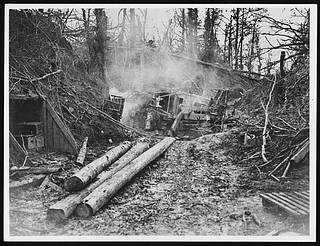
Similar
Dug-out fire in Bourlon Wood during World War I
Summary
German dugout at Bourlon Wood, France, September 1918. Part of Bourlon Wood after its capture by the Canadian Corps on 27 September 1918. To the left is the wood-lined entrance to a German dugout. In the centre there are the burning remains of a German heavy gun, identified in the caption as a Howitzer...The attack on Bourlon Wood was the beginning of the Cambrai offensive, a highly successful thrust towards the German Hindenburg Line by the British First and Third Armies. Bourlon Wood was captured by the Canadian Corps under the command of General Sir Arthur Currie (1875-1933)...[Original reads: 'A Dug-out fire in Bourlon Wood. An 8.3 German Howitzer blown over by the explosion of a dump near it. Good Canadian artillery fire is sure proof here.']..digital.nls.uk/74549246 ( http://digital.nls.uk/74549246 )
World War I (WWI or WW1), also known as the First World War, or the Great War, was a global war centred in Europe that began on 28 July 1914 and lasted until 11 November 1918. World War I Images From National Library of Schotland. These photographs form part of the papers of Field Marshal (Earl) Haig (1861-1928), held by the National Library of Scotland. More information is available from the Library's Digital Archive. Like many World War I generals, Haig remains a controversial figure. The collection contains diaries, papers and photographs from every part of Haig’s career, the Great War diaries being of special importance to historians. Photographs in the "Official Photographs" series (which were destined for publication and have captions on the back describing the image) are in black-and-white. World War I saw the development of a system of 'official’ reporting by professionals especially recruited into the forces. Initially reluctant to allow cameras near the fighting, it took some time for the authorities to appreciate the propaganda and recording potential of photography. These photographs provide us with an invaluable record of how the Government and Military wanted the war perceived. Official photographers were encouraged to record morale-boosting scenes of victory and comradeship. Despite the restrictions placed on them, official war photographers succeeded in giving the most comprehensive visual account of the war. It is important to remember that these images were propaganda; few that could depict the war in a disheartening or disconcerting way passed the censors. As a result the photograph taken was often posed. They were intended to reassure those at home and boost morale. They were printed in newspapers, and were intended to confirm that 'Tommy' was winning the war.
Tags
Date
Location
Source
Copyright info


































